Free access of the complete Ganita Prakash Book Class 6 Solutions and Chapter 1 Patterns in Mathematics Class 6 NCERT Solutions Question Answer are crafted in simple format to align with the latest CBSE syllabus.
Class 6 Maths Chapter 1 Patterns in Mathematics Solutions
Patterns in Mathematics Class 6 Solutions Questions and Answers
1.1 What is Mathematics? Figure it Out (Page No. 2)
Question 1.
Can you think of other examples where mathematics helps us in our everyday lives?
Answer:
Mathematics is everywhere and plays a crucial role in our everyday lives. Here are some examples:
- Budgeting and shopping: We use maths to manage our money. Math is useful for calculating discounts, comparing prices, or tracking expenses.
- Cooking and baking: Recipes often require measurements, proportions, and timing.
- Time management: We use math to plan our schedules, calculate travel time, estimate how long tasks will take, etc.
- Understanding patterns: Recognising patterns in weather, traffic, or daily routines involves mathematical thinking.
Question 2.
How has mathematics helped propel humanity forward? (You might think of examples involving: carrying out scientific experiments; running our economy and democracy; building bridges, houses, or other complex structures; making TVs, mobile phones, computers, bicycles, trains, cars, planes, calendars, clocks, etc.)
Solution:
Mathematics is everywhere. Mathematics has propelled humanity by economic development eradication of diseases and increase in living standards.
1.2 Patterns in Numbers Figure it Out (Page No. 3)
Question 1.
Can you recognize the pattern in each of the sequences in Table 1?
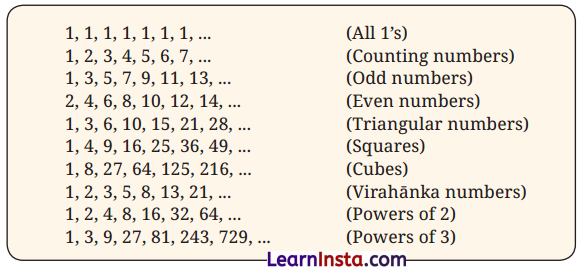
Solution:
Yes,
| Patterns | Recognization of patterns |
| 1, 1, 1, 1, 1, 1, 1,… (All l’s) | Sequence of all 1 ’s |
| 1, 2, 3, 4, 5, 6, 7, … (Counting numbers) | A sequence of consecutive counting numbers starting from 1 |
| 1, 3, 5, 7, 9, 11, 13, … (Odd numbers) | A sequence of consecutive odd numbers starting from 1 |
| 2, 4, 6, 8, 10, 12, 14, … (Even numbers) | A sequence of consecutive even numbers starting from 2 |
| 1, 3, 6, 10, 15, 21, 28, … (Triangular numbers) | In the sequence, each term is the sum of first n consecutive counting numbers |
| 1,4, 9, 16, 25,36, 49, … (Squares) | In the sequence, each term is the product of counting number by itself starting from 1 |
| 1, 8, 27, 64, 125, 216, … (Cubes) | In the sequence, each term is the product of counting number by itself thrice starting from 1 |
| 1, 2, 3, 5, 8, 13, 21, … (Virahanka numbers) | In the sequence, each term (starting from third term) is the sum of previous two terms |
![]()
Question 2.
Rewrite each sequence of Table 1 in your notebook, along with the next three numbers in each sequence! After each sequence, write in your own words what is the rule for forming the numbers in the sequence.

Solution:
- All l’s 1, 1, 1, 1,… (The next three numbers are 1, 1, 1. The rule is that every number is 1.)
- Counting numbers 1, 2, 3, 4, 5, 6, 7,… (The next three numbers are 8, 9,10. The rule is to add 1 to the previous number.)
- Odd numbers 1, 3, 5, 7, 9, 1,… (The next three numbers are 15, 17, 19. The rs to add 2 to the previous number.)n numbers 2, 4, 6, 8, 10, 12, 14,… (The next three is to add 2 to the previous number.)
- Triangular numbers 1, 3, 6,10,15, 21, 28,…
(The next three numbers are 36,45, 55. The rule is to add the next natural number is sequence.) - Squares 1, 4, 9, 16, 25, 36, 49,… (The next three numbers are 64, 81, 100. The rule is to square the next natural number.)
- Cubes 1, 8, 27, 64, 125, 216,… (The next three numbers are 343, 512, 729. The rule is to cube the next natural number.)
- Virahanka numbers 1, 2, 3, 5, 8, 13, 21,… (The next three numbers are 34, 55, 89. The rule is to add the last two numbers.)
- Powers of 2 1, 2, 4, 8, 16, 32, 64,… (The next three numbers are 128, 256, 512. The rule is to multiply the last number by 2.)
- Powers of 3 1, 3, 9, 27, 81, 243, 729,… (The next three numbers are 2187, 6561, 19683. The rule is to multiply the last number by 3.)
1.3 Visualising Number Sequences Figure it Out (Page No. 5-6)
Question 1.
Copy the pictorial representations of the number sequences in Table 2 in your notebook, and draw the next picture for each sequence!
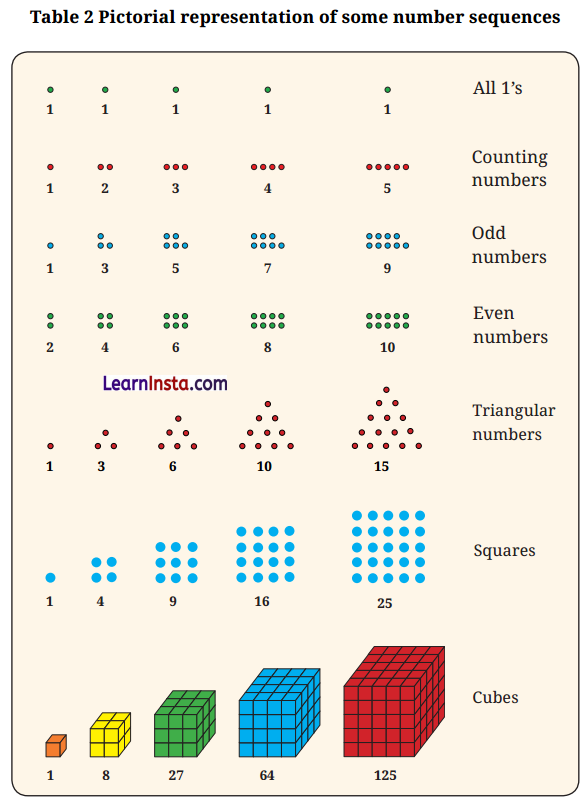
Answer:


Question 2.
(a) Why are 1, 3, 6, 10, 15,…… called triangular numbers?
(b) Why are 1, 4, 9, 16, 25,…….. called square numbers or squares?
(c) Why are 1, 8, 27, 64, 125,…….. called cubes?
Solution:
(a) Triangular numbers are called so because these numbers of dots can be arranged to make a triangle.
1, 3, 6, 10,…….. are triangular numbers.
1, 3, 6, 10,……… dots can be arranged to make a triangle. (see figure below)

(b) Square numbers are called so because these numbers of dots can be arranged to make a square.
1, 4, 9, 16,………. are square numbers.
1, 4, 9, 16,……… dots can be arranged to make a square (see fig. below)

(c) Cubes are called so because these many unit cubes can be arranged to make a cube.
1, 8, 27, 64,…… are cube numbers.
1, 8, 27, 64,……. unit cubes can be arranged to make cubes. (see figure below)

Question 3.
You will have noticed that 36 is both a triangular number and a square number! That is, 36 dots can be arranged perfectly both in a triangle and a square. Make pictures in your notebook illustrating this!
This shows that the same number can be represented differently and play different roles, depending on the context. Try representing some other numbers pictorially in different ways!
Answer:
It’s fascinating that 36 can be both a triangular number and a square number! Let’s explore this by visualizing how 36 dots can be arranged in both shapes and then represent other numbers in different ways:

Other numbers that can be represented pictorially in different ways are: 9
9 as both a square and a cross:

![]()
Question 4.
What would you call the following sequence of numbers?

That’s right, they are called hexagonal numbers! draw these in your notebook. What is the next number is the sequence?
Solution:

Question 5.
Can you think of pictorial ways to visualise the sequence of Powers of 2? Powers of 3?
Here is one possible way of thinking about Powers of 2:

Solution:

Intext Questions
Question 1. (Page 7)
By drawing a similar picture, can you say what is the sum of the first 10 odd numbers?
Solution:
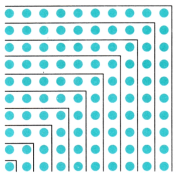
1 + 3+ 5+ 7 + 9 + 11 + 13 + 15 + 17 + 19 = 100
Question 2.
Now by imagining a similar picture, or by drawing it partially, as needed, can you say what is the sum of the first 100 odd numbers?
Solution:
Do it yourself by referring the above image.
We know that adding up consecutive odd numbers gives square numbers.
So, while adding up 100 odd number, we get a number which is square of 100.
1 + 3 + 5 + 7 + 9+ 11 + … + 197 + 199 = 10000
1.4 Relations Among Number Sequences Figure it Out (Page No. 8-9)
Question 1.
Can you find a similar pictorial explanation for why adding counting numbers up and down, i.e., 1, 1 + 2 + 1, 1 + 2 + 3 + 2 + 1,……., gives square numbers?
Solution:

1 = 1 = (1)2
1 + 2 + 1 = 4 = (2)2
1 + 2 + 3 + 2 + 1 = 9 = (3)2
1 + 2 + 3 + 4 + 3 + 2 + 1 = 16 = (4)2
1 + 2 + 3 + 4 + 5 + 4 + 3 + 2 + 1 = 25 = (5)2
1 + 2 + 3 + 4 + 5 + 6 + 5 + 4 + 3 + 2 + 1 = 36 = (6)2 and so on.
![]()
Question 2.
By imagining a large version of your picture or drawing it partially, as needed, can you see what will be the value of 1 + 2 + 3 + … + 99 + 100 + 99 + …. + 3 + 2 + 1?
Answer:
We know that by adding the counting numbers up and down, we get perfect squares as these sequences are to be thought of as forming a symmetric pattern around a central line. So, by adding counting numbers up and down to 100, we will get our central line with 100 dots and the rest above and below that line.

So 1 + 2 + 3 + ….. + 99 + 100 + 99 + …… + 3 + 2 + 1 = 1002 = 10,000
Question 3.
Which sequence do you get when you start to add the All 1’s sequence up? What sequence do you get when you add the All 1’s sequence up and down?
Solution:
Adding up: 1 + 1 + 1 + 1 = 4
Adding down: 1 + 1 + 1 + 1 = 4
The sum is the same in both ways.
Question 4.
Which sequence do you get when you start to add the counting numbers up? Can you give a smaller pictorial explanation?
Answer:
When we start adding the counting numbers cumulatively, we get the sequence of triangular numbers.
1: 1
1 + 2: 3
1 + 2 + 3: 6
1 + 2 + 3 + 4: 10
1 + 2 + 3 + 4 + 5: 15
This sequence is known as the triangular numbers.

Question 5.
What happens when you add up pairs of consecutive triangular numbers? That is, take 1 + 3, 3 + 6, 6 + 10, 10 + 15,… ? Which sequence do you get? Why? Can you explain it with a picture?
Solution:
Adding up pairs of consecutive triangular numbers.
1 + 3 = 4
3 + 6 = 9
6 + 10 = 16
10 + 15 = 25
…………
…………
…………
…………
and so on.
Here, we get a sequence of squares.

Question 6.
What happens when you start to add up powers of 2 starting with 1, i.e., take 1, 1 + 2, 1 + 2 + 4, 1 + 2 + 4 + 8,…..? Now add 1 to each of these numbers — what numbers do you get? Why does this happen?
Solution:
Let us add powers of 2 starting with 1
Here 1 = 1
1 + 2 = 3
1 + 2 + 4 = 7
1 + 2 + 4 + 8 = 15
1 + 2 + 4 + 8 + 16 = 31
Hence series 1, 3, 7, 15, 31,….. is formed.
Now let us add 1 to each of the above numbers
1 + 1 = 2 = 21
1 + 2 + 1 = 4 = 2 × 2 = 22
1 + 2 + 4 + 1 = 8 = 2 × 2 × 2 = 23
1 + 2 + 4 + 8 + 1 = 16 = 2 × 2 × 2 × 2 = 24
This happens because we are adding (1 + 1 = 2), hence the power of 2 increases.
![]()
Question 7.
What happens when you multiply the triangular numbers by 6 and add 1? Which sequence do you get? Can you explain it with a picture?
Solution:
Triangular numbers are 1, 3, 6, 10, 15, 21,…….
1 × 6 + 1 = 7
3 × 6 + 1 = 19 (increase of 12 i.e. 6 × 2)
6 × 6 + 1 = 37 (increase of 18 i.e. 6 × 3)
10 × 6 + 1 = 61 (increase of 24 i.e. 6 × 4)
15 × 6 + 1 = 91 (increase of 30 i.e. 6 × 5)
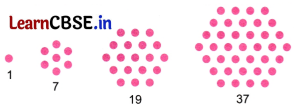
We get the sequence: 7, 19, 37, 61, 91,………..
Question 8.
What happens when you start to add up hexagonal numbers, i.e., take 1, 1 + 7, 1 + 7 + 19, 1 + 7 + 19 + 37,….? Which sequence do you get? Can you explain it using a picture of a cube?

Answer:
When you start to add up hexagonal numbers, you obtain a sequence of cubic numbers.
Let’s add them up cumulatively:
1. Sum of first hexagonal number: 1
2. Sum of first two hexagonal numbers: 1 + 7 = 8
3. Sum of first three hexagonal numbers: 1 + 7 + 19 = 27
4. Sum of first four hexagonal numbers: 1 + 7 + 19 + 37 = 64
This sequence is 1, 8, 27, 64,…..
The sequence 1, 8, 27, 64,…. is the sequence of cubic numbers: 13, 23, 33, 43, 53,…..
The cube number: Cn = n3

Question 9.
Find your patterns or relationships in and among the sequences in Table 1. Can you explain why they happen with a picture or otherwise?
Answer:
Squares are generated by adding consecutive odd numbers.
For example:
12 = 1
22 = 1 + 3 = 4
32 = 1 + 3 + 5 = 9
42 = 1 + 3 + 5 + 7 = 16

1 + 3 + 5 + 7 + 9 + 11 + 13 + 15 + 17 + 19 = 100
1.5 Patterns in Shapes Figure it Out (Page No. 11)
Question 1.
Can you recognise the pattern in each of the sequences in Table 3?
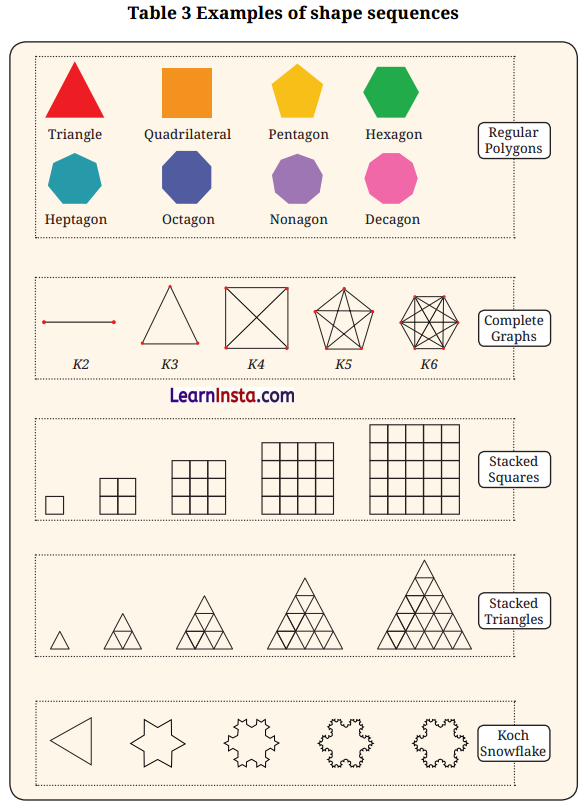
Solution:
Yes, we can recognise the pattern in each of the sequence in Table 3.
Question 2.
Try and redraw each sequence in Table 3 in your notebook. Can you draw the next shape in each sequence? Why or why not? After each sequence, describe in your own words what is the rule or pattern for forming the shapes in the sequence.
Solution:
Answer:
Regular Polygons:



![]()
1.6 Relation to Number Sequences Figure it Out (Page No. 11-12)
Question 1.
Count the number of sides in each shape in the sequence of Regular Polygons. Which number sequence do you get? What about the number of corners in each shape in the sequence of Regular Polygons? Do you get the same number sequence? Can you explain why this happens?
Solution:

Both sequences s are the same because in a regular polygon number of sides is equal to several vertices.
Question 2.
Count the number of lines in each shape in the sequence of complete graphs. Which number sequence do you get? Can you explain why?
Answer:
The number of lines in each shape in complete graphs is 1, 3, 6, 10, 15, …..
This sequence is of triangular numbers.
Why does this happen? The number of edges in a complete graph with n vertices is given by \(\frac{n(n+1)}{2}\)
This formula calculates how many ways you can choose 2 vertices out of n to form an edge, which is essentially the number of unique pairs of vertices.
Question 3.
How many little squares are there in each shape of the sequence of Stacked Squares? Which number sequence does this give ? Can you explain why?
Solution:
There are 1,4, 9, 16, 25 little squares, respectively in each of the sequence of stacked squares.
This gives a sequence of squares.
Reason
1 = 1
1 + 2 + 1 = 4
1 + 2 + 3 + 2 + 1 = 9
1 + 2 + 3 + 4 + 3+ 2 + 1 = 16
…………
…………
…………
…………
and so on.
Question 4.
How many little triangles are there in each shape of the sequence of stacked triangles? Which number sequence does this give? Can you explain why?
(Hint: In each shape in the sequence, how many triangles are there in each row?)
Answer:
The number of little triangles in each shape of the sequence of stacked triangles is: 1, 4, 9, 16,…..
The number sequence given by this is that of perfect square numbers.
Why does this happen? The number of little triangles in each shape of the sequence of stacked triangles is a perfect square because each row has triangles in increasing order: the bottom row has n triangles, the next row up has n – 1 triangles, and so on, up to the top row that has 1 triangle. The total number of little triangles in a stacked triangle shape is a sum of increasing triangular numbers.
![]()
Question 5.
To get from one shape to the next shape in the Koch Snowflake sequence, one replaces each line segment by a speed bump’
![]()
As one does this more and more times, the changes become tinier and tinier with very very small line segments. How many total line segments are there in each shape of the Koch Snowflake? What is the corresponding number sequence?
(The answer is 3, 12, 48,…, i.e. 3 times Powers of 4, this sequence is not shown in Table 1)
Solution:
There are 3,12,48,192, 768 line segments in each shape of the Koch Snowflake.
The corresponding number sequence is 3, 12, 48, ….
i. e. 3 times the powers of 4.